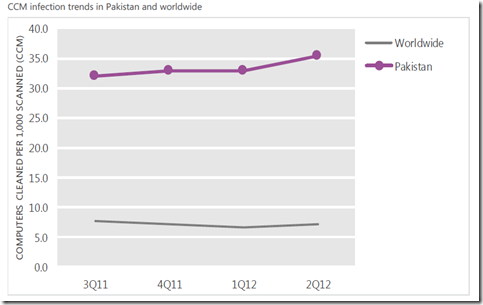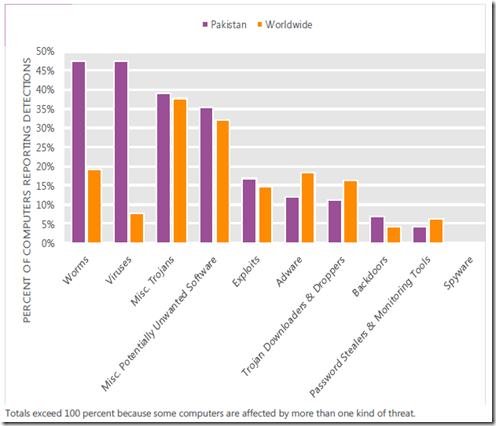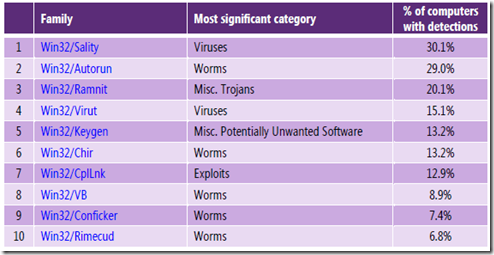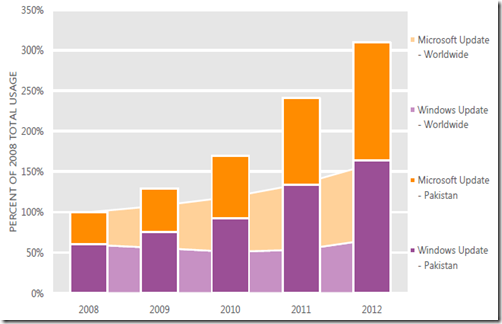Threat landscape & malware infection on computers in Pakistan
The global threat landscape is evolving. Malware and potentially unwanted software have become more regional, and different locations around the world exhibit different threat patterns.
The statistics presented here are generated by Microsoft security programs and services running on computers in Pakistan in 2Q12 and previous quarters. This data is provided from administrators or users who choose to opt in to provide da-ta to Microsoft, using IP address geo-location to determine country or region.
See the Security Intelligence Report website at www.microsoft.com/sir for more in-formation about threats in Pakistan and around the world, and for explanations of the methods and terms used here.
Infection trends (CCM)
The MSRT detected malware on 35.3 of every 1,000 computers scanned in Pakistan in 2Q12 (a CCM score of 35.3, compared to the 2Q12 worldwide average CCM of 7.0). The following figure shows the CCM trend for Pakistan over the last four quarters, compared to the world as a whole.
Threat categories
Malware and potentially unwanted software categories in Pakistan in 2Q12, by percentage of computers reporting detections
The most common category in Pakistan in 2Q12 was Worms. It affected 47.4 percent of all computers with detections there, up from 43.5 percent in 1Q12.
The second most common category in Pakistan in 2Q12 was Viruses. It affected 47.4 percent of all computers with detections there, down from 49.1 percent in 1Q12.
The third most common category in Pakistan in 2Q12 was Miscellaneous Trojans, which affected 39.1 percent of all computers with detections there, down from 40.2 percent in 1Q12.
Threat families
The top 10 malware and potentially unwanted software families in Pakistan in 2Q12
Windows Update and Microsoft Update usage in Pakistan and worldwide
Microsoft provides several tools and services that enable users to download and install updates directly from Microsoft or from update servers designated by their system administrators. The update client software (called Automatic Updates in Windows XP and Windows Server 2003, and simply Windows Update in other currently supported versions of Windows) connects to an update service for the list of available updates. After the update client determines which updates are ap-plicable to the user’s computer, it installs the updates or notifies the user that they are available, depending on the way the client is configured and the nature of each update.
For end users, Microsoft provides two update services that the update clients can use:
- Windows Update provides updates for Windows components and for device drivers provided by Microsoft and other hardware vendors. Win-dows Update also distributes signature updates for Microsoft antimalware products and the monthly release of the MSRT. By default, when a user enables automatic updating, the update client connects to the Windows Update service for updates.
- Microsoft Update provides all of the updates offered through Windows Update and provides updates for other Microsoft software, such as the Microsoft Office system, Microsoft SQL Server, and Microsoft Exchange Server. Users can opt in to the service when installing software that is ser-viced through Microsoft Update or at the Microsoft Update Web site (update.microsoft.com/microsoftupdate). Microsoft recommends config-uring computers to use Microsoft Update instead of Windows Update to help ensure they receive timely security updates for Microsoft products.
Enterprise customers can also use Windows Server Update Services (WSUS) or the Microsoft System Center family of management products to provide update services for their managed computers.
This chart shows the growth in the number of computers connecting to Windows Update and Microsoft Update in Pakistan over the last four years, indexed to the total usage for both services in Pakistan in 2008.
In 2012, the number of computers connecting to Windows Update and Microsoft Update in Pakistan was up 28.5 percent from 2011, and up 209.7 percent from 2008. By comparison, worldwide use of the two services increased 18.3 percent between 2011 and 2012, and 59.7 percent from 2008 to 2012.
Of the computers using the two update services in Pakistan in 2012, 47.0 percent were configured to use Microsoft Update, compared to 58.5 percent worldwide.
Few important tips to help you stay safer online
In wake of these evolving threats, it is highly recommended to take appropriate measures to stay secure when going online. Check the recommendations on following URL to ensure online safety:
https://www.microsoft.com/security/family-safety/online-safety-tips.aspx
_______________________________________________________________________________________________________________________
Source: https://www.microsoft.com/sir Microsoft Security Intelligence Report [Full Report can be accessed here]
January through June, 2012
This document is for informational purposes only. MICROSOFT MAKES NO WARRANTIES, EXPRESS, IMPLIED, OR STATUTORY, AS TO THE INFORMATION IN THIS DOCUMENT
This document is provided “as-is.” Information and views expressed in this document, including URL and other Internet website references, may change without notice. You bear the risk of using it.




